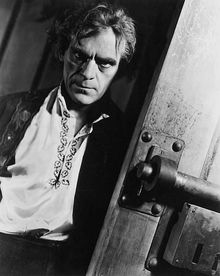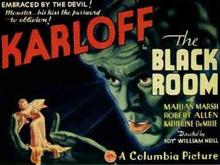Our editor-in-chief Nate Yapp is proud to have contributed to the new book Hidden Horror: A Celebration of 101 Underrated and Overlooked Fright Flicks, edited by Aaron Christensen. Another contributors include Anthony Timpone, B.J. Colangelo, Dave Alexander, Classic-Horror.com's own Robert C. Ring and John W. Bowen. Pick up a copy today from Amazon.com!
The Black Room (1935)
It is difficult to find many horror films made within a few years of Frankenstein (1931) where Boris Karloff is not wearing some kind of monstrous makeup. Even in The Black Cat (1934), his character wears a faux widow's peak to suggest a demonic appearance. However, in 1935's The Black Room, Karloff foregoes the heavy greasepaint and prosthetics, stripping his acting to the bare bones of the profession -- vocal inflection, body language, and that light of thought flickering behind the eyes. As a bonus, he gives a bravado double performance, playing both halves of a set of identical twins.
After years of self-imposed exile, Anton de Berghmann (Boris Karloff) returns to his family home at the behest of his slightly older twin, Baron Gregor de Berghmann (also Karloff). A family curse states that Anton will kill Gregor in the titular room, but Gregor scoffs at the old superstitions. It seems he's become something of an unpopular ruler, what with the murdering of townswomen and all. He wants Anton's help in restoring order -- or so he claims. After handing over the barony to Anton, Gregor thows his brother down a pit in the Black Room. With his dying breath, Anton promises that he will fulfill the prophecy and kill his twin. Gregor dismisses this as nonsense and assumes his brother's identity, allowing him to continue his rule of the land under the appearance of benevolence. However, ill deeds such as Gregor's rarely go unpunished, especially when there's a prophecy involved...
Plot-wise, The Black Room is really more of a Gothic melodrama than a horror film. While Gregor is clearly a malevolent character, there is nothing macabre or fantastic about him or his plots. The circumstance behind his eventual demise is ironic, but hardly supernatural. Much of the narrative involves mundane political and/or romantic maneuvering; one major plot involves Gregor's attempts to woo the beautiful Thea (and her father's wealth), first as himself and then as Anton. Because of the lack of overt indicators of the genre, one could make the convincing argument that the main reason that The Black Room is identified as a horror film is the casting of Karloff in the lead.
 Boris Karloff is evil brother Gregor in Roy William Neill's The Black Room (1935). Publicity photo from doctormacro.com.
Boris Karloff is evil brother Gregor in Roy William Neill's The Black Room (1935). Publicity photo from doctormacro.com.However, to say that Karloff's mere presence is the reason for The Black Room's inclusion in the genre undercuts the power of his performance. Gregor is rough, unkempt, and guttural. His limbs hang from their joints, as if good posture is a luxury wasted on fools. The only happiness he does portray is a dark amusement, complete with a unsettling smirk. As written, Gregor could have been merely evil -- Karloff makes him cruel and that cruelty propels The Black Room from horror adjunct to full member of the genre.
Karloff's ability to amaze us does not end here. Compared to Gregor, his Anton is a startling contrast: a sprightly, cultured fellow whose personality probably closely matches Karloff's real-life temperament. He's somewhat foppish, but with an earnest streak. All of these attributes are well-conveyed without a word of dialogue in their favor -- they are entirely carried by Karloff's body language and vocal inflection. As if two roles were not enough, Karloff then combines the roles into one when Gregor impersonates Anton. While the other characters sees "Anton" and his good posture (which may have lost a little of its strength) and kind bearing (although he does let loose a dark jibe here and there), behind the eyes is the fiendish Gregor, laughing maniacally at his ruse. Karloff maintains this chilling dichotomy in every scene where it is required and it is a delight to behold.
Director Roy William Neill's sense of atmosphere serves him well in The Black Room. The de Berghmann castle in particular reeks of antiquity, the interiors bathed in shadows, dust, and cobwebs. The onyx-lined Black Room lives up to its name, especially in one chilling sequence where Gregor rehearses his imitation of Anton in front of the reflective wall. Not only is the wall black, but so is Gregor's mirror image. Later in the movie, Neill lets the visual quality slip in favor of a fast-pace but ultimately hokey chase sequence featuring rear projection, sped-up photography, and a mastiff that can keep pace with a horse-drawn carriage moving at full gallop.
Despite this minor flaw, The Black Room is a fine feature for those who prefer their horror films understated and their monsters entirely human. With some of the finest acting of his career, Boris Karloff makes the whole package work. And so does Boris Karloff.








